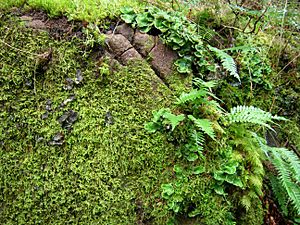Licorice fern facts for kids
Quick facts for kids Licorice fern |
|
|---|---|
 |
|
| Scientific classification | |
| Genus: |
Polypodium (plant)
|
| Species: |
glycyrrhiza
|
The licorice fern (Polypodium glycyrrhiza) is a cool plant found in western North America. It's also known as the "many-footed fern" or "sweet root." This fern loves shady, damp places and loses its leaves in the summer.
You can find its spores, which are like tiny seeds, in round spots called sori on the underside of its leaves. These spores are released when the weather is cool and humid.
Contents
About the Licorice Fern
The licorice fern is special because its leaves, called fronds, don't all grow from one central spot. Instead, they pop up from different places. This is why it's called Polypodium, which means "many-footed."
Its fronds are shaped like triangles and have jagged edges. They are usually at least one foot long, but some can grow to be over two feet! The veins in the leaves run side by side.
The fern has a reddish-brown underground stem called a rhizome. This rhizome creeps along the ground and has a sweet taste, just like licorice! Since it's a fern, it doesn't have flowers or seeds. It reproduces using spores that grow in spots on the back of its leaves. The licorice fern can grow on the ground, on rocks, or even on other plants as an epiphyte.
It's important to know that the licorice fern is not related to the plant used to make the licorice candy you might eat. That plant is called Glycyrrhiza glabra.
Why it's Called Licorice Fern
The name glycyrrhiza comes from ancient Greek words. Glykys means "sweet," and rhiza means "root." So, its name literally means "sweet root," which makes sense because of its sweet-tasting rhizome!
Where Licorice Fern Grows
This fern mostly grows in a narrow strip along the coast. You can find it in southern Alaska, southwestern Yukon Territory, western British Columbia, Washington, Oregon, and California. There are also a couple of small groups of them far away in Idaho and Arizona.
Its Home and How it Lives
The licorice fern loves places that are wet. So, you'll often see it on moist ground, on rocks, or on old logs. Sometimes, it even grows on fallen trees. It especially likes to grow near bigleaf maple trees.
This fern has a cool trick: it can team up with tiny fungi in the soil. This partnership helps the fern get nutrients. The licorice fern grows best during the mild, wet winters. It uses the nutrients from fallen leaves of other trees to grow when most other plants are sleeping. It usually lives in low areas, below 600 meters (about 2,000 feet) in height.
What Makes it Sweet
Scientists used to think the sweet taste of the rhizome came from a substance called glycyrrhizin. But now, studies show that the sweetness might actually come from something else called polypodoside. This substance is super sweet – about 600 times sweeter than a sugar solution!
Growing Licorice Fern
People sometimes grow licorice fern in their gardens because it's a beautiful plant. There's even a special type called 'Longicaudatum' that has won an award for being a great garden plant.
How People Use Licorice Fern
Many Native American groups used to chew the rhizomes of the licorice fern for its sweet flavor. This included groups like the Squamish, Shishalh, Comox, Nuxalk, Haida, and Kwakwaka'wakw. The rhizomes were also used as a traditional medicine to help treat colds and sore throats.
Images for kids





